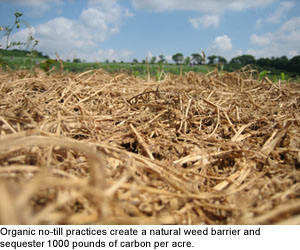09
Jul
New “Natural” Brand Poses Threat to Organic Market
(Beyond Pesticides, July 9, 2009) Recent news that Dean Foods intends to launch a “natural milk” brand has organic consumers and retailers concerned. Horizon, a strictly organic brand up until now, is poised to sell products that are not certified organic. This new product category will offer conscientious consumers what appears to be a cheap alternative to organic, when in fact it is nothing more than a conventional product in a fancy package. Despite recent news that the organics industry as a whole continues to grow in this economy, encouraging consumers to steer away from the certified organic label with misleading product claims purports to devastate the organic movement and organic family farm.
“This move by Dean Foods comes at a time when organic dairy farmers around the country are in financial crisis due to a glut of milk,” says Mark A. Kastel, Senior Farm Policy Analyst at The Cornucopia Institute. “Responsible participants in this industry are using their marketing strength to ramp up organic demand. Dean has instead chosen to profiteer at the expense of the hard-working family farmers who have built this industry.”
The USDA Organic Label is intended to show consumers that the product adheres to uniform standard which meet the requirements of the Final National Organic Program Rule. An expose by The Washington Post this past week however, “Purity of Federal ‘Organic’ Label Is Questioned”, highlights some of the recent problems that the organic industry faces including the recent news by Dean Foods. Under the Organic Foods Production Act, 5% of a USDA certified organic product can consist of synthetic substances as long as the organic version is not commercially available and it is approved by the National Organic Standards Board. Instead of getting smaller, the original list of 77 substances in 2002 has grown to 245 due to lobbying efforts on the part of companies who want a piece of the organic market. You can read more about the history, standards and pesticide regulation of organic standards on our organic food program page. Provisions in the the new 2008 Farm Bill are intended to strengthen support for organic and organic transition.
It is absolutely crucial that we, as consumers, don’t play victim to this latest food-industry scam. In a national survey examining consumer perception on food labeling, Suzanne Shelton claims that people prefer ”˜natural’ to ”˜organic,’ believing that organic is an unregulated word used to increase the price of a product, even though the complete opposite is true. The marketing of ”˜natural’ dairy products under the Horizon brand umbrella by Dean is just a ploy to further confuse shoppers.
However, explains Mr. Kastel: “Dean Foods will not be able to mention that the products are produced without pesticides, herbicides, antibiotics and other drugs, and genetically modified feed crops, or that the cows are required to graze in pastures rather than confined to factory farm feedlots. These are all factors that truly differentiate organic production from natural/conventional agricultural and livestock production.” It’s important that consumers know what the labels mean. Our publication, “Making Sure Green Consumer Claims are Truthful”, is a handy guide on how to read through these so-called “eco-labels.”
Beyond Pesticides believes it is critical that we ensure the integrity and growth of organic practices and advocates choosing local, organic foods whenever possible. You can write a letter to Dean Foods’ Chairman Greg Engel and urge him to also ensure the integrity of organics by reconsidering this atrocious marketing ploy.













 Incidents with flea and tick products can involve the use of spot-on treatments, sprays, collars and shampoos. However, the majority of the incidents reported to EPA are related to flea and tick treatments with EPA-registered spot-on products. Spot-on products are generally sold in tubes or vials and are applied to one or more localized areas on the body of the pet, such as in between the shoulders or in a stripe along the back. This advisory pertains only to EPA-registered spot-on flea and tick products; these products have an EPA registration number on the label.
Incidents with flea and tick products can involve the use of spot-on treatments, sprays, collars and shampoos. However, the majority of the incidents reported to EPA are related to flea and tick treatments with EPA-registered spot-on products. Spot-on products are generally sold in tubes or vials and are applied to one or more localized areas on the body of the pet, such as in between the shoulders or in a stripe along the back. This advisory pertains only to EPA-registered spot-on flea and tick products; these products have an EPA registration number on the label.
